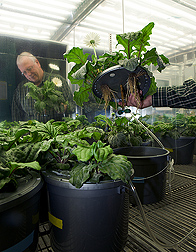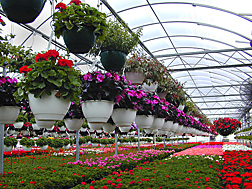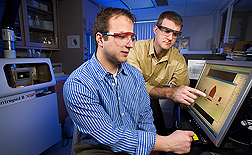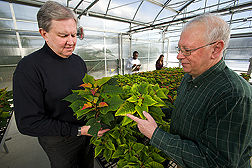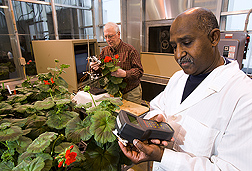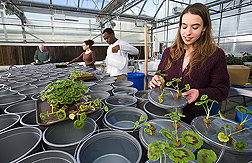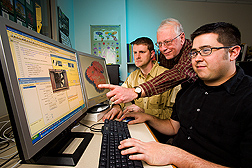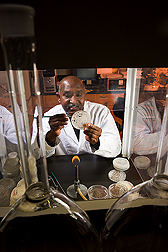For top-notch greenhouse production,
growers first need to know . . .
What Plants REALLY Want!
|
|
The greenhouse manager of the future walks around the greenhouse, pointing an infrared flashlight at potted plants. A tiny screen tells whether each plant has too much, too little, or just the right amount of nutrients. The manager doesn’t worry about water because he lets a computer worry about that for him. The computer reads moisture sensors that trigger irrigations only as needed.
The top two concerns of greenhouse operators are to make sure their valuable plants aren’t ruined by too little or too much water and to provide them with optimal nutrients. And these issues should also be the top two research priorities for Agricultural Research Service scientists working on commercial greenhouse production.
That’s what ARS plant pathologist Jim Locke and ARS horticulturist Jonathan Frantz learned a few years ago, after extensive contact with Ohio’s booming greenhouse and nursery industry. In 2001, in response to a congressional initiative, Charles Krause, research leader of the ARS Application Technology Research Unit (ATRU) at Ohio State University (OSU) at Wooster, Ohio, formed a team to research ways to overcome priority problems faced by the floricultural greenhouse industry in the Great Lakes region, to make American producers more competitive globally.
|
|
In 2002, Locke relocated to Toledo, Ohio, from the Henry A. Wallace Beltsville (Maryland) Agricultural Research Center. Six months later, Frantz joined him there. By 2003, the ARS Greenhouse Production Research Group (GPRG), a worksite of ATRU, was fully operational, working to shape the industry’s automated future.
The group operates out of a complex of labs, offices, and greenhouses on the University of Toledo’s main campus. It also leases about 8,000 square feet of greenhouse space from the nearby public Toledo Botanical Garden. The garden provides ARS and university researchers with meeting space for grower focus sessions and offers expertise in transferring research information to growers. The garden also houses 18 county horticulture organizations, including OSU Extension, Urban and Consumer Horticulture, the Master Gardener Volunteer Program, and Green Industry Education.
Scoping Out the Industry’s Needs
At the very beginning, Locke and Frantz toured greenhouses throughout northern Ohio to talk with industry people about priority problems and to observe the operations themselves.
“When we made a short list of the top problems that could be researched to find solutions, we realized that all of them had nutrition or water as a common theme,” Frantz says. “So we made those the top research areas for our group to focus on.”
“Plants need good nutrition to grow well and avoid diseases,” adds Locke. “And healthy plants need fewer chemicals, such as fungicides, insecticides, or growth regulators. We’re researching use of soilless media as a way to further protect plants against disease and hold water and nutrients for them. When you’re growing plants in pots, you have the opportunity to replace the soil entirely and eliminate possible soilborne pathogens—if you can find a cost-effective way to do it.”
“Seeing” Nutrient Needs, Molecularly
Locke and Frantz have made a lot of progress toward their goals in the past 3 years. Frantz is testing commercial nutrient sensors as he tries to design improved portable sensors. “Devices like these can give growers a few extra days to correct nutrition problems before their plants are seriously damaged,” he says.
To develop better portable sensors, he and colleagues are testing ways to spot nutrition problems by identifying key proteins or other molecules associated with stress. One of these ways is bouncing infrared light off plants to analyze the molecules present. “You can see these proteins start working before you ever see any evidence of damage in the stressed plant,” Frantz says.
The GPRG’s current research with silicon offers a window into how the group operates with all the nutrients it studies, such as nitrogen, phosphorus, potassium, and trace elements like magnesium. This is true even though—unlike those other nutrients—the research community doesn’t yet agree on whether silicon is even an essential plant nutrient. Frantz and Locke want to find out whether it is essential and, if so, just how much it can benefit plants. To ascertain this, they use various research tools such as hydroponic culture—growing plants in a nutrient-water solution.
For example, in a recent experiment with zinnias, the scientists delivered silicon in irrigation water given to plants growing in potting mixes; they added silicon to the hydroponic solution in which other plants were growing. Then they exposed the seedlings to powdery mildew, a common disease of greenhouse plants.
|
|
The scientists examined leaf tissue using scanning electron microscopy with energy dispersive spectrometry x-ray analyzers at Wooster to determine silicon content and location. They assessed the mildew visually and documented their observations with digital photography, which was analyzed with special software to pinpoint the areas of powdery mildew development.
After observing the zinnias daily for 4 to 6 weeks, the scientists then harvested them and determined the final total silicon content of leaf tissue using inductively coupled plasma (ICP) spectrometry. With ICP, plant tissue samples are burned in very hot plasma, which is created as argon gas becomes electrically conductive after passing near a coil that generates high-energy radio waves. The combustion creates a light spectrum that makes it possible to identify elements including silicon, phosphorus, potassium, copper, magnesium, and boron.
Frantz and Locke found that significant amounts of silicon had accumulated in the harvested zinnia leaves. The silicon also decreased the severity of symptoms of powdery mildew infections in the zinnias. Next, the scientists will use similar tests to see whether silicon accumulates in the leaves of begonias, geraniums, and other ornamental crops.
“We want to see which crops put nutrients where they are most useful to the plant. It will help breeders choose promising lines for creating new varieties of flowers and ornamental plants that will need fewer pesticide applications,” Locke says.
How Do Nutrients Protect?
Locke says that he and colleagues have found that silicon helps to reduce both insect and disease problems in geraniums and begonias as well as in zinnias. In fact, “an ARS postdoctoral researcher working with these plants has found that silicon can reduce the incidence or severity of the two most common foliar diseases of horticultural plants—powdery mildew and Botrytis cinerea,” Locke says. Now they’re using these diseases as models to evaluate the role of mineral trace elements on plant disease resistance.
“Foliar fungal diseases of herbaceous bedding plants pose a serious management challenge to greenhouse growers,” says Krause. “Disease can spread rapidly in a greenhouse, where so many plants are so close together. We want to find out how nutrients protect plants from diseases. For example, do they build protection in the cell walls, or do they activate plant defense mechanisms?”
Locke, working with Krause and OSU researchers, found that a potting mix of composted hardwood bark, peat moss, and certain types of the beneficial fungus Trichoderma could combat Botrytis gray mold on plant leaves. “In begonias, it reduced this mold more than the standard fungicide chlorothalonil did,” Locke says.
But Locke and colleagues have found that more isn’t necessarily better with regard to applying nutrients. In tests on begonia and New Guinea impatiens grown in sphagnum peat moss/perlite potting mixes, they applied various rates of nitrogen and then infected the plants with gray mold. They found that it doesn’t pay to add more than 100 parts per million of nitrogen. “After that, you can green up the plants just before sale, but you do so at the possible expense of more disease and poorer overall plant growth and appearance,” says Locke.
In addition to the University of Toledo and OSU, the ARS scientists work with colleagues at North Carolina State University, the University of Florida, Michigan State University, and the Cooperative Extension Services in Michigan, North Carolina, and Ohio.
“We’re the new kid on the block, so we take advantage of the years of expertise at the more established laboratories in those institutions,” Frantz says.
Wired!
Krause warns visitors that “if you are at the Toledo Botanical Garden and see government vehicles, individuals in white lab coats, or plants growing with unusual equipment attached, you should think of it as the plant equivalent of the University of Toledo’s medical college.
“To do our research, we have many strange-looking sensors, gadgets, wires, and computers connected to the potted plants so we can measure and record everything from nutrient levels in their leaves to moisture in the soil or potting media,” says Krause. “We’ve deliberately inoculated pathogens into some plants to help us study the various stress symptoms resulting from nutrient deficiencies, moisture conditions, and disease interactions.
“We advise observers to think of this research area as an intensive care unit for plants—one that’s similar to hospital units where patients are monitored with wires, tubes, and other devices to facilitate recovery. Similarly, we need to carefully monitor the research plants to obtain the information we need to develop better recommendations for growing ornamentals more efficiently and economically.”
Toward Totally Automated Production
In one greenhouse, there’s a small scale, called a “lysimeter,” under each potted plant. The soil gets lighter as water moves through and out of the plant. Some of the water applied to the plant is also captured in the lysimeter box and sampled periodically for quality. The researchers also test the quality of the water before it’s applied.
“From these lysimeters, we gain an understanding of how much water plants need so we can give them just the right amount and at the right timing and pace,” Locke says. “We will eventually automate watering based on the data we get from these lysimeter experiments.”
Thanks to research findings to date, Frantz, Locke, and Krause have published “Virtual Grower” software, which is available on the World Wide Web. It can help growers manage their greenhouses for greater productivity at lower costs. The current version focuses on energy requirements, helping growers choose the best fuel and heating schedules. It is available, free of charge, by going to www.ars.usda.gov/services/software/software.htm and scrolling down to “Virtual Grower.”
Frantz and Locke will gradually expand the software to include all aspects of greenhouse management, including applications of nutrients, water, growth regulators, and pesticides. Ultimately, it will also help growers to manage labor, optimize plant productivity, and set sale prices.
According to Frantz, “There are many individual programs like this, but none that considers all these factors interacting together as this one will.”—By Don Comis, Agricultural Research Service Information Staff.
This research is part of Crop Production (#305) and Plant Diseases (#303), two ARS National Research Programs described on the World Wide Web at www.nps.ars.usda.gov.
James C. Locke and Jonathan M. Frantz are with the USDA-ARS Greenhouse Production Research Group, 2801 W. Bancroft St., Mail Stop 604, Toledo, OH 43606; phone (419) 530-1595 [Locke], (419) 530-1531 [Frantz], fax (419) 530-1599.
Charles R. Krause is in the USDA-ARS Application Technology Unit, 1680 Madison Ave., Wooster, OH 44691; phone (330) 347-6789, fax (330) 263-3670.
"What Plants REALLY Want!" was published in the May/June 2007 issue of Agricultural Research magazine.







